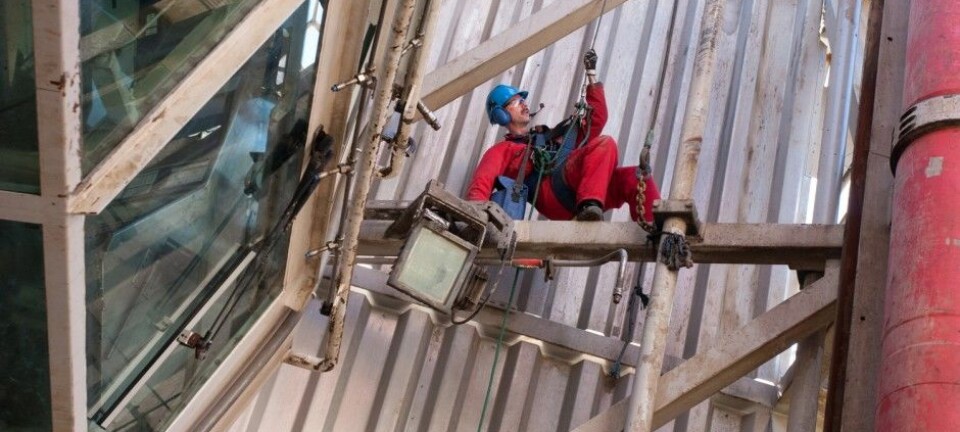
People who work in open-plan or shared offices get sick more often
Employees in open-plan workspaces take more sick leave than those with their own offices. If you share an office with one or more colleagues, your risk of taking sick leave increases significantly, a new Norwegian study shows.
Open-plan workspaces have become more common in recent decades. Although this arrangement seems like it should save money, a new study suggests that it has a hidden cost.
Employees working in open workspaces or sharing an office cost employers and society more in the form of increased sickness absence, according to a new study from the Norwegian National Institute of Occupational Health, STAMI.
“This is a factor that few business leaders have considered so far. But they should take this cost into account if chosing to have an open-plan workspace, because it has a bearing on the bottom line,” says Professor Stein Knardahl, research director at STAMI.
In Norway, employers pay sick pay to employees for their first 16 days of leave before NAV, the Norwegian Labour and Welfare Administration, takes over.
Significant increase in sickness absences in open offices
Two other Scandinavian studies have shown that working in open-plan workspaces is linked to increased sickness absence. But these studies are based on the employees' own information about their sick leave.
To address this problem, a group of researchers at STAMI used official data registers to see if workplace design could affect the risk of sick leave.
They compared medically registered sick leave over 12 months among more than 6300 employees who worked in various types of office workspaces in Norway.
And they found clear differences.
Employees who worked in open-plan workspaces had a 12 per cent increased risk of sickness absence certified by a doctor than those with their own offices.
Those who shared offices with one or more colleagues had an 18 per cent higher risk than those with their own private office.
There are likely several reasons for this, the researchers believe.
More viruses and disruptions
“Sickness absence is related to many different factors. It is natural to think that open-plan workspaces would mean an increased risk of infection from viral infections,” says Knardahl.
Another factor may be because sounds and movements of colleagues in open workspaces and shared offices can be disruptive. The need to concentrate more, combined at times with irritation and noise, can contribute to fatigue and headaches.
Different group dynamics, less personal control and privacy can also play a role in increasing the risk of sick leave.
21 doctor-approved sick days on average
Participants were recruited from 97 companies that were involved in a major project on working environment.
Among more than 30,000 employees, 6,328 employees were analysed after the researchers eliminated those who did not work in an office.
The researchers got access to how many days of sick leave the employees had over the course of one year, but not the diagnosis.

The employees had an average of 21 doctor-approved sick days. This translated into four weeks a year per employee of work absence due to illness.
Employees with their own offices had an average of less than 20 days of sick leave. Workers who were in an open workspace took an average of 22 days of sick leave, while those who shared an office with others had 25 days of sick leave.
“We were taken aback when we saw that absence levels were so high. But probably some long-term sick leave pulled the average numbers up,” says Knardahl.
In addition, the composition of the companies can play a role in sick leave numbers. The study included several municipalities, several ministries and a large insurance company, he says.
Do employees actually need to sit physically close to each other?
The study has a number of strengths, says Randi Wågø Aas. She is an occupational therapist and professor of occupational health at the University of Stavanger and Oslo Metropolitan University.
But Aas would like more information about which employee groups participated, and an analysis of how sick leave looks for different types of jobs.

“You have to ask what the goal of introducing an open-plan workspace was. If the goal was to create more interaction because the work demands it, that’s a completely different situation than when people are put in open-plan workspaces despite the fact that the employees primarily work independently and need to concentrate,” Aas said.
She thinks more studies are needed that assess the goal of sitting in an open-plan workspace compared to the actual needs of workers to sit together.
“If you look at workers with jobs that demand concentration, the risk may increase even more than the researchers at STAMI found,” she says.
“The challenge with these kinds of studies is also that it’s not possible to control for all other causes of sick leave, except that the person is sitting in an open-plan office or closed, private office,” Aas says.
Half have their own office
More than half of the participants in the STAMI study worked in their own office. Twenty-seven per cent shared offices with one or more colleagues, and 16.5 per cent worked in open-plan workspaces.
The absence did not apply to a particular year, but to a 12-month period for each participant, after submitting a questionnaire on the working environment.
The study covers the years between 2004 and 2014.
“This allowed us to avoid seasonal variations in sick leave and socio-economic changes that can have an impact,” Knardahl said.
Sickness absence was counted only if it had been registered by a medical doctor with the Norwegian Labour and Welfare Administration, NAV. Self-reported sick leave of up to three days was not included in the study.
“The strength of this study is that we only used objective data for the period after surveying office types and sick leave registered with NAV,” Knardahl said.
Self-reported sick leave information can be unreliable because people's memories are not always correct, Knardahl says.
In addition, physician certified sick leave reflects more serious health problems.
No difference between gender, age, position
The researchers found no difference in the risk of sick leave, depending on the gender, age, educational level or whether they had leadership roles or not.
The study says nothing about how often employees had sick leave, but only recorded the number of sick leave days the employee registered during the 12 months following their inclusion in the study.
Other studies show the same trends
Previous studies have also shown that there is a connection between health, wellness and self-reported sick leave and how office space is designed.
A previous study from 2013 with more than 1800 participants showed that Swedish employees working in open-plan offices have higher self-reported sick leave than those who didn’t. This was true for both short-term and long-term sick leave.
A Danish study from 2011 has also established that employees in open-plan workspaces or who shared offices with other colleagues have more days of sick leave than those with their own offices. A total of 2,400 participants participated.
Knardahl emphasizes that sickness absence is due to many factors, including each individual’s private circumstances.
The design of the workplace is only one of many factors that are important in determining sick leave numbers, he says.
“Since many business leaders focus on the savings of having an open-plan office, it may be appropriate to include the costs of sickness absence associated with this type of workspace in the calculation,” says Knardahl.
References:
M. B. Nielsen and S. Knardahl: The impact of office design on medically certified sickness absence. Scandinavian Journal of Work, Environment and Health. doi:10.5271/sjweh.3859
C. B. Danielsson et al.: Office design's impact on sick leave rates. . Ergonomics, 27 January 2014. Summary
J. H. Pejtersen et al.: Sickness absence associated with shared and open-plan offices - a national cross sectional questionnaire survey. . Scandinavian Journal of Work, Environment and Health, September 2011. Summary
———


































